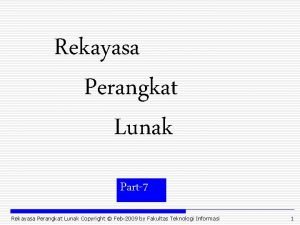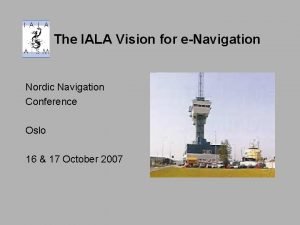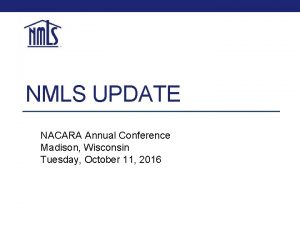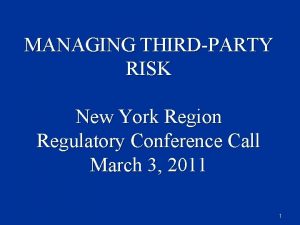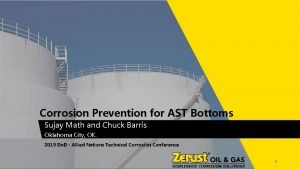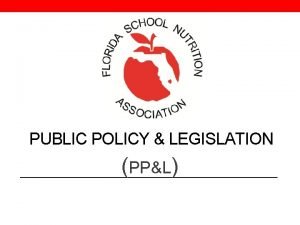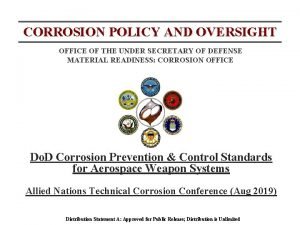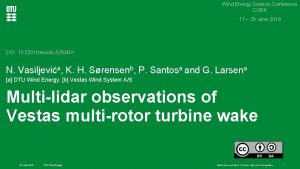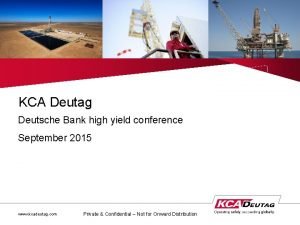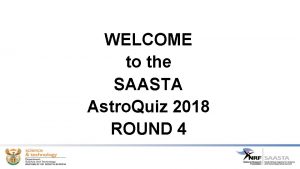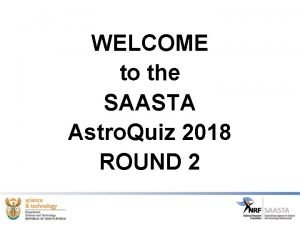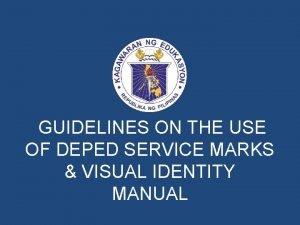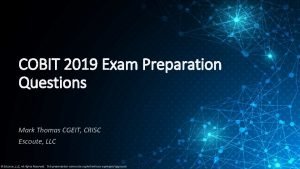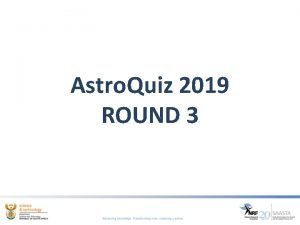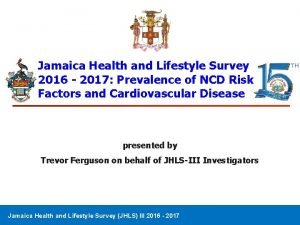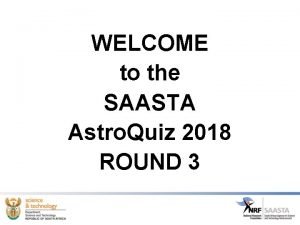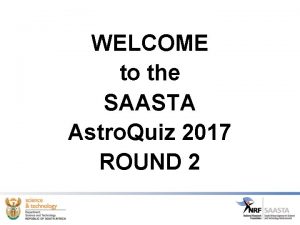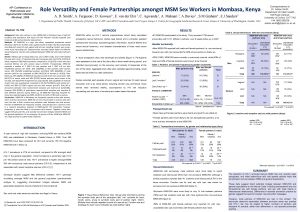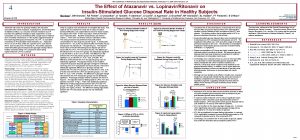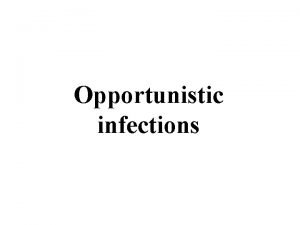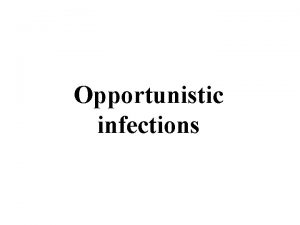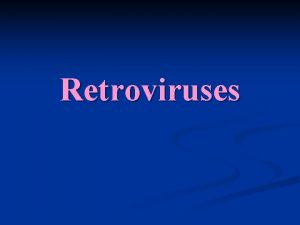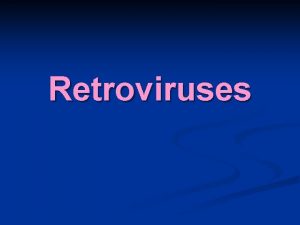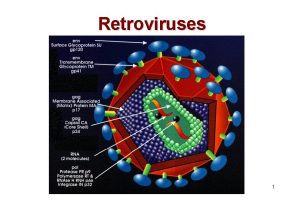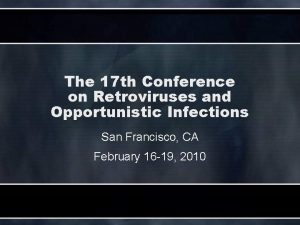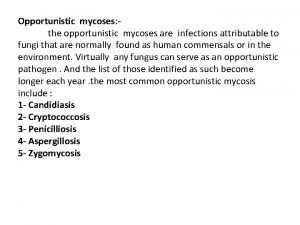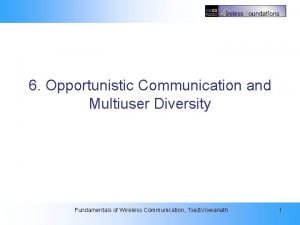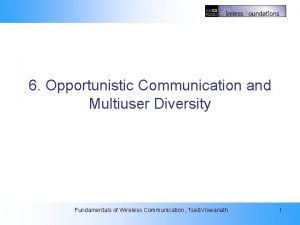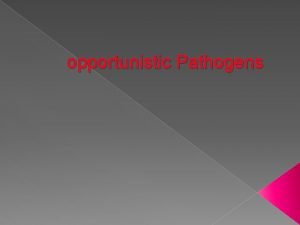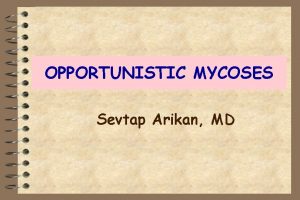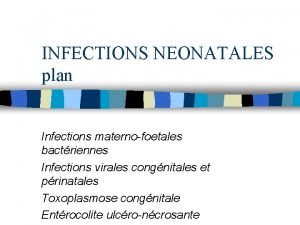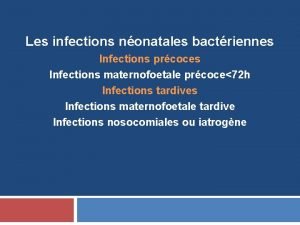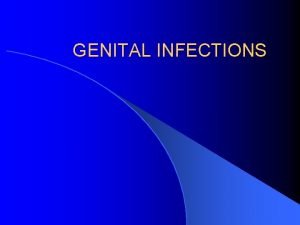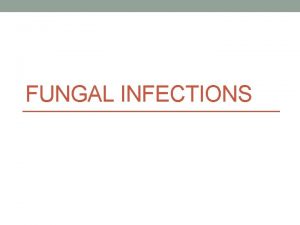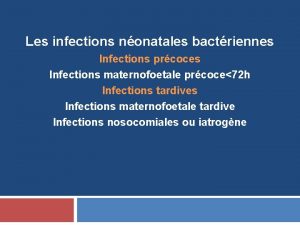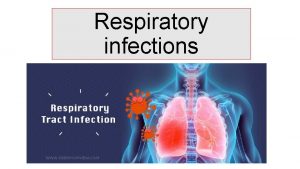Conference on Retroviruses and Opportunistic Infections CROI 2019













































- Slides: 45

Conference on Retroviruses and Opportunistic Infections (CROI) 2019 March 4 to March 7, 2019, Seattle, USA Faculty Pedro Cahn, Buenos-Aires, Argentina Anton Pozniak, London, UK François Raffi, Nantes, France Institutional partners

Late pregnancy EFV vs DTG LA CAB + RPV IM ATLAS & FLAIR Late pregnancy EFV vs RAL ARV strategies B/F/TAF efficacy with pre-existing resistance 2 DR 3 TC/DTG GEMINI

RAL vs EFV in pregnancy : RCT % with Delivery VL < 200 c/ml Overall and by Gestational Age at Entry (N = 307 women) p = 0. 001 94% 100 90 Interaction p = 0. 04 97% 96% • Median time to VL < 200 copies/m. L: – RAL: 8 days – EFV: 15 days 93% 84% 80 71% 70 EFV 60 50 RAL 40 30 20 10 0 Overall 90 88 89 95 20 to < 28 W 28 to < 37 W • 5 infants born with HIV – RAL: 1 – EFV: 4 – All with PCR+ at birth (intra-uterine transmission) Mirochnick M, CROI 2019, Abs. 39

Dol. PHIN-2 : RCT of dolutegravir vs efavirenz-based therapy initiated in late pregnancy Background • In South Africa, a fifth of HIV+ pregnant women initiate ART late, in 3 rd trimester • Late initiation : 7 -fold increased risk of MTCT, + 2 -fold infant mortality in 1 st year Hypothesis: Faster VL declines with DTG may reduce MTCT at birth & during breastfeeding in HIV+ mothers initiating ART in 3 rd trimester Study design Inclusions : Women ≥ 18 years , HIV+, and pregnancy N = 123 test positive ≥ 28 w Uganda = South Africa Exclusions : prior ART > 1 year, prior INSTI, prior NNRTI failure, abnormal lab measures, d-d-I N = 126 with EFV or DTG Delivery 2 w 6 w 12 w 24 w 48 w 72 w EFV + 2 NRTI DTG + 2 NRTI Kintu K, CROI 2019, Abs. 40

Do. IPHIN-2 Primary Endpoint: VL < 50 copies/m. L (ITT) Time to VL < 50 c/m. L (primary endpoint) 1, 0 Time to VL < 1000 c/m. L 92. 6% 1, 0 DTG EFV 73. 8% 0, 8 DTG EFV 0, 6 42. 6% 0, 4 0, 2 RR 1. 11 (95%CI 1. 00 – 1. 23; P=0. 05) RR 1. 66 (95%CI 1. 32 – 2. 08; P<0. 0001) 0 82. 6% 0, 8 0 15 30 45 60 Days since randomisation 75 0 0 15 30 45 60 75 Days since randomisation Median (IQR) time on ART at delivery: (DTG 52 [30 – 74] days vs EFV 59 [38 – 82]) days

Do. IPHIN-2 Infant Transmissions 3 infant transmissions – all in the DTG arm Enrolment (gestation week) Duration of ART predelivery (days) 1 2 3 32 32 30 35 32 24 VL (c/m. L) at baseline 48969 32844 31354 D+7 5211 210 258 D+28 503 100 ND Delivery 29 20 200 Delay delivery-PCR+ in infant (days) 5 3 11 Safety Mothers and Infants DTG N = 137 EFV N = 131 ≥ 1 drug-related SAE 1. 5 % 3. 8 % ≥ 1 IRIS-related SAE 0. 7 % 1. 5 % Sillbirths * N = 4 (2. 9%) 0 Infants DTG N = 123 EFV N = 119 Deaths N = 5 (4. 1%) N= 3 (2. 5%) Congenital, familial and genetic ** 38. 2% 37. 8% Mothers * 2 not related (maternal syphilis) ; 3 unlikely (maternal syphilis, post-dates with fetal distress, sepsis with possible TB) ** no differences in system organ class frequencies between groups Kintu K, CROI 2019, Abs. 40

Gemini 1 & 2 studies : 3 TC + DTG vs FTC/TDF + DTG Kaplan-Meier of Time to Viral Target Not Detected : Overall Participants By baseline HIV RNA S 48 1, 0 0, 8 S 48 1, 0 0, 6 0, 8 0, 4 0, 6 0, 2 0, 4 0 DTG + 3 TC DTG + TDF/FTC 0 4 8 12 16 DTG + 3 TC 0, 2 Baseline HIV-1 RNA < 100 000 c/ml 24 36 DTG + TDF/FTC 0 0 4 8 1216 24 36 48 60 72 S 48 1, 0 0, 8 Baseline HIV-1 RNA > 100 000 c/ml 0, 6 0, 4 DTG + 3 TC 0, 2 DTG + TDF/FTC 0 0 4 8 12 16 24 36 48 60 72 Time to target not detected, weeks Underwood M. CROI 2019, Abs 490

B/F/TAF efficacy in patients with archived pre-existing resistance 2 patients with archived M 184 V % 98 99 97 95 1 000 200 100 50 0 0 Archived M 184 V/I (N = 44) 10 000 12 HIV-1 RNA < 50 c/ml 1 3 5 HIV-1 RNA > 50 c/ml HIV-1 RNA (c/ml) 2 0 B/F/TAF 24 36 Visit date (weeks) 0 48 DRV/RTV + RPV 10 000 IQR Last on-treatment HIV-1 RNA : 1 000 61 c/ml (not genotyped) 1 000 20 100 Preexisting substitutions RT : K 70 K/R, M 184 M/V IN : none BLQ 10 With primary resistance (N = 159) 40 IQR 1 000 No primary resistance (N = 286) 60 10 000 RT : M 184 V IN : none Pooled B/F/TAF (N = 570) 80 DRV/RTV + RPV 200 100 50 10 Preexisting substitutions RT : M 184 M/I/V IN : none 0 0 12 24 36 Visit date (weeks) BIC (Ctau (ng/ml) 100 B/F/TAF 10 000 BIC (Ctau (ng/ml) HIV-1 RNA at last follow-up (median 116 weeks) and VF to B/F/TAF HIV-1 RNA (c/ml) • 2 randomised switch studies (1878 & 1844) • Historical plasma genotypes + baseline HIV proviral DNA genotyping 0 48 Andreatta K. CROI 2019, Abs 552

LA CAB + RPV IM as maintenance : 2 studies ATLAS and FLAIR ATLAS (N = 616) FLAIR (N = 629) • On 2 NRTI + PI or NNTI or INSTI > 6 months and HIV-1 RNA < 50 c/m. L • Randomisation 1 : 1 • Treatment induction with ABC/3 TC/DTG x 20 weeks • 566 Randomised 1 : 1 • W 48 outcome : HIV RNA ≥ 50 c/ml • Virologic failure with RNA > 200 c/ml • Discontinuation for injection site pain in LA group = 4 (1%) – Continue current oral ART – weeks lead-in CAB + RPV oral, then LA CAB + RPV IM every 4 ± 1 weeks – 5 in LA arm (1. 6%) – 3 in oral ART (1%) – Non-inferiority demonstrated – 3 in LA group : emergence of RPV-R in 3 and of INSTI-R in 1 (2 subtypes A 1 + 1 subtype AG) – 4 in ART group : emergence of R in 3 – Continue current oral ART – 4 weeks lead-in CAB + RPV oral, then LA CAB + RPV IM every month – 6 in LA arm (2. 1%) – 7 in oral ART (2. 5%) – Non-inferiority demonstrated – 4 in LA group : emergence of RPV-R + INSTI-R in 3 (All 3 = HIV subtype A 1) – 4 in oral ART group : no emergence of INSTI-R Swindells S, Abs 139, Orkin C. Abs. 140 LB

TDF-TAF switch Kidney INSTI and NTD More data Jury still out ! ch it w s F A T TDF ipids L ART Toxicity Weight gain on INSTI JAK inhibitor for residual inflammation Immun osenes cence and CM V and Inf lamma tion

Reversibility of renal function after TDF-TAF switch ? • Retrospective analysis, Icona Foundation Cohort Estimated probabilities of recovery of e. GFR to pre-TDF values Boosted INSTI versus unboosted regimens 1, 00 • 1726 switched F/TDF to F/TAF, maintaining the same third drug ± same booster – 1009 without boost – 717 with boost (EVG/c: 559, DRV/b: 158) • Median follow-up 8 months Predictors of e. GFR recovery to pre-TDF values 0, 75 Unboosted 0, 50 Log rank p = 0, 033 EVG/c 0, 25 0 0 Number at risk 824 447 p 0, 75 CDC Stage C 0. 83 (0. 55 - 1. 25) 0. 365 0, 50 Age (+ 10 years) 0. 96 (0. 87 -1. 06) 0. 427 0, 25 Years of TDF exposure (+ 1 year) 0. 90 (0. 86 - 0. 94) < 0. 001 Boosted vs unboosted regimen 0. 74 (0. 59 - 0. 92) 0. 008 15 36 63 Boosted PI versus unboosted regimens 1, 00 a. IRR (95% CI) 5 10 Months from switch 716 507 304 131 406 313 239 141 Unboosted Log rank p = 0, 227 EVG/c 0 0 Number at risk 824 121 5 10 Months from switch 716 507 304 131 109 84 61 27 15 36 9 Gagliardini R. CROI 2019, Abs 693

TDF-TAF switch : lipids worsening • OPERA database, US, 93 170 PLWHIV • Switching from TDF to TAF was associated with less favorable lipid profiles • Lipid changes were not driven by boosting agent use : less favorable profiles after switch regardless of boosting agent use * 100% * * * 80% 60% 40% 20% 0% TDF TAF TDF CHOL % patient in each category TAF TDF HDL LDL TAF TG Severe 0. 7% 1. 9% 3. 4% 6. 5% NA NA 1. 5% 2. 5% Dylipidemia 4. 4 % 7. 6% 12. 1% 16. 0% 34. 8% 30. 2% 19. 7% 24. 5% Borderline 19. 1% 25. 6% 31. 1% 32. 2% 48. 1% 48. 2% 17. 6% Normal 75. 9% 64. 9% 53. 4% 45. 4% 17. 1% 21. 6% 61. 6% 55. 3% * p-value for the pre-post switch comparison < 0. 0001 Mallon P. CROI 2019, Abs 652

JAK inhibitor to decrease residual chronic inflammation • ACTG 5336: open-label RCT ; Ruxolitinib 10 mg bid x 5 weeks + ART vs ART alone • 60 patients (40 RUX), median CD 4 737/mm 3 Fold Change in IL-6 (pg/m. L) Ruxilitinib Fold Change in s. CD 14 (ng/m. L) No Sudy treatment Ruxilitinib 5, 0 2, 00 4, 5 1, 75 3, 0 Mean (95%CI) 4, 0 P = 0. 18 2, 5 2, 0 FC 1. 10 FC 0. 93 1, 5 1, 0 P = 0. 03 1, 50 FC 1. 10 FC 0. 97 1, 25 1, 00 0, 75 0, 50 0, 5 0 Number of Participants No Sudy treatment 0, 25 37 Bsl 37 36 18 Wk 4/5 Wk 10/12 Bsl Study Week 18 17 Wk 4/5 Wk 10/12 number of Participants 37 Bsl 37 35 18 Wk 4/5 Wk 10/12 Bsl 18 17 Wk 4/5 Wk 10/12 Study Week Marconi VC. CROI 2019, Abs 37 LB

Change in weight before and after switch to INSTI ACTG Cohort • Prospective observational cohort • ACTG A 5001 and A 5322, with long term follow-up post end of trial • Restriction of analysis to patients who switched for INSTI while having HIV RNA < 200 c/ml at switch – Evaluation of weight change overtime for each individuals and predicted change in weight according to age Participants characteristics (N = 691) Median age 51 Male, % 82 Ethnicity : black/hispanic, % 26/19 CD 4 currents/nadir, median/mm 3 BMI (kg/m 2), median 610/185 26, 9 ARV before switch to INSTI : PI / NNRTI, % 63 / 35 NRTI at switch to INSTI : ABC/TDF/TAF, % 25/49/14 Smoking/Diabetes, % 57/12 • Adjusted difference in annual weight gain, following switch to INSTI was significant : • Multivariate linear mixed effects model to • for women evaluate weight change before and after ‒ Blacks: + 0, 9 kg/yr (p = 0. 04) switch to INSTI – Adjustment on age at switch, sex, ethnicity, initial BMI, nadir CD 4, % time with HIV RNA < 200 c/m. L, smoking, diabetes ‒ ‒ Whites: +1, 4 kg/yr (p = 0. 02) ≥ 60 years: + 2 kg/yr (p = 0. 008) Obeses (BMI > 30) : + 1, 7 kg/yr (p = 0. 002) ≤ 40 years : - 2, 5 kg/yr (p = 0. 02) • for men ≥ 60 yr : + 0, 8 kg/yr (p = 0. 004) Lake JE. CROI 2019, Abs 669

Change in weight before and after switch to INSTI Change in weight post switch to INSTI Change in weight pre/post switch to INSTI 100 95 DTG : +1. 3 kg/year 90 90 80 EVG/c : +0. 9 kg/year 85 70 RAL : +0. 3 kg/year Follow-up since ART initiation -20 -14 -10 -4 -2 0 2 4 10 80 83 0 2 4 6 8 10 Years since INSTI switch 82 Follow-up 2 years before and after switch 81 80 79 -2 -1 -0. 5 0 0. 5 1 2 PI RAL NNRTI RAL PI EVG/c NNRTI EVG/c PI DTG NNRTI DTG PI INSTI NNRTI INSTI -2 -1 0 1 2 Lake JE. CROI 2019, Abs. 669

Weight gain after starting first line INSTI: NA-ACCORD Cohorts • Prospective observational study, 17 NA-ACCORD cohorts • ART naive patients starting first line of triple ART (NNRTI, PI, INSTI) between 2007 et 2016 • Multivariate linear mixt effects model, adjusted for age, sex, ethnicity, baseline weight, CD 4, Viral load, year of ART initiation and cohort site • Censoring if virologic failure, ART switch or lost to follow up Participants characteristics (N = 24 001) NNRTI (N = 11 825) PI (N = 7 436) INSTI (N = 4 740) p Median age, years 43 42 39 < 0. 05 Male, % 90 80 86 < 0. 05 Black, % 42 43 40 < 0. 05 2010 2014 < 0. 05 BMI (kg/m 2), median 25 25 25 < 0. 05 CD 4/mm 3, median 312 262 360 < 0. 05 HIV RNA, log 10 c/ml, median 4. 6 4. 7 4. 6 < 0. 05 Year ART start, median Bourgi K. CROI 2019, Abs. 670

Weight gain after starting first line INSTI: NA-ACCORD Cohorts Predicted weight changes (5 years of ART initiation) Predicted weight changes (2 years of INSTI initiation) 86 86 +6. 0 DTG INSTI +4. 9 +5. 1 84 PI +4. 4 +4. 9 84 RAL +4. 3 82 ART class/INSTI group INSTI-based NNRTI-based PI-based 0 1 2 NNRTI 82 ART group 80 +3. 8 EVG NNRTI +3. 3 PI 3 4 Years since ART initiation NNRTI-based PI-based RAL DTG EVG 80 5 0. 0 0. 5 1. 0 1. 5 2. 0 Years since ART initiation Bourgi K. CROI 2019, Abs. 670

Weight gain on ARV : risk factors (US Cohort) • Retrospective study, 4 US regions • Of 20 953 patients on ARV, selection of 6 721 who switch for a new regimen between Aug 2013 and Aug 2017, with undetectable viral load at switch and during follow up ; 3 468/6 721 had BMI measure at Day 0 (switch) and during follow up Population characteristics (N = 3 468) Mean age Male, % Ethnicity : black/ white, % CD 4/mm 3, mean BMI (kg/m 2) : < 18. 5 / > 30, % ARV : INSTI / NNRTI / PI, % Comorbidities, % CKD CVD Diabetes Hyperlipidemia Hypogonadism Psychiatric disorders 47, 5 81 28 / 61 657 1 / 39 64 / 28 / 20 9 12 8 36 19 16 Mc. Comsey GA. CROI 2019, Abs. 671

Weight gain on ARV : risk factors (US Cohort) Multivariate analysis of weight gain > 3% Underweight at baseline 1. 77 [0. 9, 3. 4], 0. 091 Psychiatric Disorder 1. 28 [1. 0. 1. 61. 0. 020 Female 1. 25 [1. 0, 1. 6], 0. 055 Age < 30 1. 16 [0. 9, 1. 6], 0. 346 Hypertension 1. 15 [0. 9, 1. 4], 0. 148 Hyperlipidemia 0. 96 [0. 8, 1. 2], 0. 682 INSTI use 0. 95 [0. 7, 1. 3], 0. 740 CVD 0. 88 [0. 7, 1. 1], 0. 315 Diabetes 0. 85 [0. 6, 1. 2], 0. 310 Age 50+ 0. 84 [0. 7, 1. 0], 0. 051 CKD 0. 81 [0. 6, 1. 1], 0. 168 Hypogonadism 0. 81 [0. 6. 1. 0]. 0. 050 NNRTI use 0. 79 [0. 6, 1. 1], 0. 125 Overweight at baseline 0. 69 [0. 6, 0. 8], <0. 001 Obese at baseline 0. 62 [0. 5, 0. 8], <0. 001 PI use 0. 58 [0. 4, 0. 7], <0. 001 0, 00 1, 00 2, 00 3, 00 4, 00 Mc. Comsey GA. CROI 2019, Abs. 671

Weight gain after switch to INSTI in virologically suppressed patient : HIV Outpatient study • Retrospective analysis • > 2 measures of BMI before switch and > 1 after switch • Censoring if second switch, switch off INSTI • Multivariate linear model • Switch for INSTI = 368 for non-INSTI = 285 28 Body Mass Index • 653 patients with HIV RNA suppressed > 1 year, switching to new regimen with or without INSTI between 2007 and 2017 Comparison 27 p value RAL vs Non-INSTI 0, 004 DTG vs Non-INSTI 0, 002 EVG vs Non-INSTI 0, 23 RAL vs DTG 0, 03 RAL vs EVG 0, 04 DTG vs EVG 0, 003 DTG RAL Non INSTI 26 EVG/c 25 24 -200 -100 0 100 Months from switch (0 is time of switch) Palellla FJ. CROI 2019, Abs. 674

BMI changes after PI or INSTI ART initiation Yearly BMI changes 0, 5 • Monocentric study (Dallas), 2009 -2017 • Comparison of early change in BMI following PI or INSTI initiation according to ‒ gender ‒ ethnicity Women Men 0, 4 0, 3 0, 2 0, 1 0 ATV DRV LPV RAL EVG DTG Blacks 0, 6 Hispanics 0, 5 Whites 0, 4 0, 3 0, 2 0, 1 0 -0, 1 ATV DRV LPV RAL EVG DTG Bedimo R. CROI 2019, Abs. 675

No weight gain in HIV negative individuals on CAB LA • Phase 2 a, 199 uninfected individuals, randomised, placebo-controlled • 2 dose/dose-interval regimens of CAB vs Placebo, duration 41 weeks Primary Outcome : Median Change in weight (Kg) CAB vs PBO 1, 0 p = 0, 66 +1, 1 (-0, 9 ; 3) +1, 0 (-1, 2 ; 3, 2) p = 0, 65 +0, 9 (-1, 2 ; 2, 8) PBO +0, 7 (-1, 5 ; 2) 0, 75 ≥ 5% Weight increase CAB 24 (22%) PBO 7 (18 %) p = 0, 62 p = 0, 60 0, 5 +0, 4 (-0, 4 ; 1) 0, 25 0 CAB +0, 1 (-0, 6 ; 1) Overall (W 0 -> 41) n = 108 n = 38 Oral phase (W 0 -> 4) n = 108 n = 38 Injection phase (W 5 -> 41) n = 108 n = 38 Landovitz RJ, CROI 2019, Abs. 34 LB

Neural tube defects and exposure to INSTI at conception • National French Perinatal Cohort, 301 exposed at conception (218 RAL+ 41 DTG + 42 EVG) No NTD • Merck Prospective reports, 456 exposed to RAL at conception No NTD • Merck Retrospective Report, 435 exposed to RAL 2 cases of NTD (exposure during conception) • 4 PV databases (FDA, WH 0, EMA, UK), too many limitations: no denominator, no systematic reporting, exact timing of ARV exposure relative to conception often not clear • Antiretroviral Pregnancy Registry, 688 exposed at conception (280 RAL+ 201 DTG + 207 EVG) No NTD (limitations: retrospective cases (reports after birth with defect), no denominator, potential bias in reporting) Sibiude J, Abs. 744 ; Shamsuddin H. Abs. 745 ; Hill A. Abs. 746 ; Albano J. Abs. 747

TAF/FTC In Pr. EP HPV therapeutic vaccine Pr. EP STI Resistance post Pr. EP TAF/EVG Vaginal insert Syphilis Lymphogranuloma proctitis

DISCOVER study: daily F/TAF vs F/TDF for Pr. EP • 5387 MSM or TGW with high sexual risk of HIV (HIV and HBV negative, could have used Pr. EP before), 94 sites, 11 countries • Randomisation 1: 1 : F/TAF vs F/TDF daily for 96 weeks Primary endpoint analysis: HIV incidence 22 HIV infections in 8756 PY of follow-up Incidence Ratio (95% CI) HIV incidence Rate/100 PY HIV Incidence 0, 34 0, 6 Favors F/TAF Favors F/TDF Noninferiority 0, 5 0, 4 0, 16 0, 3 0, 2 0, 1 0 15 infections 0, 47 4386 PY 0, 19 7 infections 1, 15 4370 PY F/TAF F/TDF n = 2694 n = 2693 0. 08/100 0. 45/100 Not on Pr. EP = 4. 02/100 0 1 1, 62 NI margin 2 F/TAF is noninferior to F/TDF for HIV prevention • • Bone, renal safety better TAF vs TDF Clinical AE, Incidence of STI same in both groups Hare B. CROI 2019, Abs. 104 LB

Impact of Pr. EP on drug resistance in Acute HIV Infection • NY City 2015 -2017 : 3685 newly diagnosed HIV infections (< 12 months) • 91 (2%) reported pre-diagnosis Pr. EP use – HIV more frequently diagnosed at acute infection stage in Pr. EP users (33% vs 9%) – Negative HIV PCR pre-Pr. EP initiation • Checked within 2 preceding days in 5% • Not checked in 75% • Checked 15 -24 days before, > 30 days before in 2% and 18%, respectively • Genotype at HIV diagnosis available in 63% of total population (75% of Pr. EP users) – M 184 V/I significantly more frequent in Pr. EP users (29% vs 2%) – No K 65 R in Pr. EP users Misra K, CROI 2019. Abs. 107

TAF/EVG vaginal insert for on-demand topical Pr. EP • Protection against vaginal SHIV infection with an insert containing TAF and EVG • Conclusion : Vaginal administration of inserts containing TAF and EVG was highly effective in preventing SHIV infection in a macaque model that mimics vaginal transmission of HIV in women. The data support the clinical development and first-in-human testing of TAF/EVG inserts for on-demand topical prophylaxis against vaginally acquired HIV infection Dobard C. CROI 2019, Abs. 101

Cervical cancer: HPV vaccine as adjuvant to LEEP • Randomised double-blind placebo trial: HPV quadivalent vaccine vs placebo + LEEP treatment of HIV infected women with cervical HSIL • Procedures: – Vaccine at D 0, W 4 and W 26, LEEP at W 4 – Assessment (colposcopic biopsies) at W 26 and W 52: recurrence of cervical HSIL • Results: 90 women in each group (50% with CIN 2, 50% with CIN 3), median age 39 years, median CD 4 489/mm 3, nadir CD 4 116/mm 3 Endpoint HPV vaccine (N = 87) Placebo (N = 87) RR (95% CI), p 52. 9 % 44. 8% 1. 2 (0. 97 – 1. 6), p = 0. 29 Histologic HSIL CIN 2 or CIN 3 32 % 31 % 1. 04 (0. 67 – 1. 6), p = 0. 8 CIN 3 10 % 13 % 0. 82 (0. 36 – 1. 9), p = 0. 64 Primary endpoint Cytologic or histologic HSIL Firnhaber C. CROI 2019, Abs. 14

MK-8591 GS-9131 New NRTI GS-9722 PGT 121 New ARVs GS 6207 Capside inhibitor GSK 2838232 Maturation inhibitor

MK-8591 potency and PK provide high inhibitory quotients at low doses QD and QW [MK-8591 -TP] PBMC (pmol/106 cells) 10 0. 25 mg MK-8591 0. 75 mg MK-8591 1 0, 1 0 10 20 30 Time (days) 40 MK-8591 -TP concentration time profile with QW dosing Week 1 10 10 1 1 0. 1 [MK-8591 -TP] PBMC (pmol/106 cells) 100 0 2 4 6 Time (days) 10 mg QW 0 2 4 6 8 10 12 100 10 1 D D / D D W Q ID Q QD g Q B g D g Q g g g m 5 m m 0 m m mg Q 25 m 00 7 0 0 0 , 2 2 , 1 3 5 0 0 TC AF 1 0 91 DF 91 C 1 30 F T 9 5 T T 5 8 3 8 85 KKKM M M Week 3 100 MK-8591 administered at low doses exhibits substantially higher inhibitors quotients than marketed NRTIs Ctrough inhibitory quotient MK-8591 -TP concentration time profile with QD dosing 14 Time (days) 30 mg QW 100 mg QW Grober JA. CROI 2019, Abs. 481


GS-9131 • Broad range of activity against HIV-1 subtypes • Pro-drug of the GS-9148 with low potential for mitochondrial and renal toxicity • Maintains in vitro activity against HIV-1 viruses harboring most major NRTI resistance mutational pathways GS-9131 EC 50=0. 29 -48 n. M in PBMCs GS-9148 -Diphosphate lnhibits HIV reverse transcription by chain termination EC 50=10 m. M in MT-2 cells Illanca-Ibanescu R. CROI 2019, Abs. 482

GS-6207, novel HIV-1 capside inhibitor • Well suited for extended-release parenteral formulation • Phase 1, 40 healthy volunteers, single dose SC escalation cohorts (8 active – 2 placebo): 30 mg, 100 mg, 150 mg, 450 mg • • • Tmax: 21 to 35 days Terminal half-life: 30 to 38 days Measurable concentrations for at least 16 weeks Increase in exposure dose proportional Good tolerability and safety Sustained delivery supports dosing interval of at least 3 months Sager JE, Abs. 141

GSK 2838232, novel maturation inhibitor • Co-administered with cobicistat 150 mg • Phase IIa, 33 HIV infected patients: 4 QD doses x 10 days tested (20 mg, 50 mg, 100 mg, 200 mg) • Results – Steady state D 8 – T 1/2 16 -19 h – Mean reduction in HIV RNA dose-dependent (-1. 70 Log 10 c/ml at D 11 with higher dose of 200 mg) – Emergence of signature resistance in 2/28 patients tested – Favorable safety De. Jesus E, Abs. 142

PGT 121, monoclonal antibody • PGT 121: recombinant human Ig. G 1 m. Ab targetting a V 3 glycandependent epitope region of HIV Env. • Potent neutralizing antibody in vitro and on SHIV in monkeys • Phase 1 – 20 HIV- and 15 HIV+ on ART: PK of various single doses sc or iv. – Second part : 1 iv injection of 30 mg/kg in 11 HIV+ not on ART • Results – Safe, well tolerated – T 1/2 22 days – 9 HIV + patients with ”high VL” (3. 3 to 5 log 10 c/ml) : 5 responders (median drop in VL of 1. 7 log 10 c/ml by D 10) and 4 non responders • In the 5 responders, rebound by D 28 with emergence of resistance – 2 HIV+ patients with low “viral load” (2. 2 and 2. 6 log 10 c/ml) : virologic suppression, with 1 rebound at D 140 (no resistance), 1 sustained up to D 168 Stephenson KE, Abs. 145 LB

GS-9722 • 1 st-in-class, effector-enhanced b. NAb for the targeted elimination of HIV-infected cells currently in Phase 1 • Engineered variant of the human antibody PGT 121, with – – – Similar neutralization breadth Enhanced effector function Optimized PK Less immunogenicity risk And improved drug-like properties • Future studies: GS-9722 in combination with – – Other effector-enhanced b. NAbs Immune-modulatory agents Latency reversal agents Therapeutic vaccines Thomsen N, Abs. 356

Cure research Cure or Remission after HSCT ARV strategies

Pembrolizumab, anti-PD 1 • 29 HIV patients on ART with tumors • Phase 1 : Penbrolizumab 200 mg iv every 3 weeks HIV RNA after Pembrolizumab 1, 5 1, 0 0, 5 0 Pembrolizumab 1 8 Days 15 22 Intracellular HIV DNA 5, 0 p = 0, 11 4, 0 3, 0 2, 0 1, 0 0, 0 Pembrolizumab 1 8 Days 15 22 2, 5 2, 0 p = 0, 004 2, 0 1, 5 1, 0 p = 0, 02 0, 5 0 Intracellular unspliced RNA/DNA Fold-change from Baseline p = 0, 008 2, 0 Plasma HIV RNA Fold-change from Baseline 2, 5 Fold-change from Baseline Unspliced Intracellular HIV RNA HIV DNA and us. RNA/DNA after Pembrolizumab 0, 5 Pembrolizumab 1 8 Days 15 22 0 Pembrolizumab 1 8 Days 15 22 • Transient increase in HIV transcription in CD 4+ T-cells in vivo in individuals on ART consistent with latency reversal • No increase in plasma HIV RNA after administration of 2 doses Uldrick TS, CROI 2019, Abs. 27

18 months HIV remission after homozygous CCR 5 delta 32 allogenic HSCT 18 (Fe mon b 2 ths 01 off 9) CA R T t 2 01 PE 7) T C rem T: iss lymp ion De hom c 2 a 01 7 T ( AR P c STO RPV + 3 TC + DTG 600 1 000 400 100 200 <1, 3 <0, 9 <0, 8 CD 4 count (cells/µL) VL (copies/ml plasma) 10 000 TDF+FTC +RAL Sep All o 10 -HSC 0 % T ( M Mi Chim ay 20 ld g eri sm 16) ut Gv HD Sto p C sa • HIV male diagnosed 2003, Hodgkin 2013 : F/TDF/EFV then F/TDF + RAL (ABVD chemo) • May 2016 : Allo-HSCT (unrelated 9/10 HLA high-resolution match), donor homozygous CCR 5 D 32 mutation <0, 8 0 10 -215 -141 -27 +29+77 +150 0 +424 +510 Time post HSCT (d) +1028 Gupta RK, CROI 2019, Abs. 29 LB

18 months HIV remission after homozygous CCR 5 delta 32 allogenic HSCT 100 10 000 1 000 50 10 0 1 -215 -141 Hematological treatment -27 +29+77 +150 0 LACE +424 +510 Time after allo-HSCT (Days) αCD 52 MTX Chimerism (% donor cells) HIV-DNA (copies/106 cells) Cellular HIV-1 DNA Reservoir Measurements +1028 q. PCR <0. 65 LTR copies/million CD 4 cells q. PCR <0. 69 Gag copies/million CD 4 cells dd. PCR LTR: 7/8 negative and 1 low level pos Bosman, Nijhuis et al JIAS 2018 Cs. A IUPM<0. 286 IUPM<0. 309 IUPM<0. 063 • Adaptive immune responses declining or absent post transplant ‒ Loss of antibody responses to HIV-1 ‒ Loss of HIV-1 specific T cell responses Gupta RK, CROI 2019, Abs. 29 LB

HIV Cure Research : Summary • Latent reservoir ‒ Remains enigmatic ‒ lmproved understanding of measurement, clonal expansion, timing • Reservoir reduction ‒ Substantial, but incomplete reductions provide valuable lessons ‒ Early ART a priority in infants and adults ‒ Likely need enhanced immunity to maintain durable suppression • lmmunotherapy ‒ Many new promising strategies ‒ Safety needs to be addressed first ‒ Combination strategies hold promise

Immunotherapy strategies • • • Toll-like receptors IL-15 IFN-alpha Therapeutic vaccines CAR T-cells • Phase 1 clinical trials of single and combination therapies 20 weeks of PEG-IFN a-2 b : significant of inducible CD 4 -associated HIV in ART suppressed individuals : rationale for use of PEG-IFN immunotherapy as componenet of cure-directed strategies Azzoni L, Abs. 136 Delayed viral rebound during ATI after infusion of CCR ZFN (Zinc Finger Nuclease)-transfected CD 4 T cells Tebas P, Abs. 25 DUOCAR : HIV-1 based lentiviral vectors encoding chimeric antigen receptors (CAR) targeting multiple highly conserved sites on HIV-1 Env using a 2 molecule CAR architecture. DUOCAR-T Cells potentially eliminate broad neurtalizing antibodies resistant to HIV in vivo (humanized intrasplenic model) Anthony-Gonda K. Abs. 359

Bn. Ab Advances • Enhanced breadth: Trispecific bn. Ab starting clinical trials Trispecific HIV antibodies demonstrate potent neutralization • Enhanced effector function and ADCC in vitro, and mediate antiviral activity in vivo Pegu A. Abstract 28 LB • Clinical trials (ongoing or in development) • 2 long-acting bn. Abs (PGT 121, GS-9722) ‒ ln chronic & acute HIV+ adults, infants, adolescents • Combination: bn. Abs + LRA or immunomodulators ‒ TLR 7/9 (GS-9620); HDACi; IL-15 Super. Ag; therapeutic vaccines, etc.


Next ARV-Trials. com webinars: IAS, Mexico EACS, Basel 25 th July 2019 9 th November 2019
 Retroviruses and opportunistic infections
Retroviruses and opportunistic infections Opportunistic infections
Opportunistic infections Opportunistic infections
Opportunistic infections Opportunistic approach adalah model proses
Opportunistic approach adalah model proses Isp curriculum
Isp curriculum Chapter 25 sexually transmitted infections and hiv/aids
Chapter 25 sexually transmitted infections and hiv/aids Understanding the mirai botnet
Understanding the mirai botnet Bone and joint infections
Bone and joint infections Can methotrexate cause yeast infections
Can methotrexate cause yeast infections Storch infections
Storch infections Storch infections
Storch infections Cryptosporidiose
Cryptosporidiose Eye infections
Eye infections Postpartum infections
Postpartum infections Genital infections
Genital infections Genital infections
Genital infections Ciliary escalator
Ciliary escalator Acute gingival infections
Acute gingival infections Ba conference 2019
Ba conference 2019 Iala conference 2019
Iala conference 2019 Fasfaa conference 2019
Fasfaa conference 2019 Esop conference 2019 las vegas
Esop conference 2019 las vegas Nmls annual conference 2019
Nmls annual conference 2019 Third party risk management conference 2019 new york
Third party risk management conference 2019 new york Executive assistant conference 2019
Executive assistant conference 2019 2019 dod allied nations technical corrosion conference
2019 dod allied nations technical corrosion conference Ppl members
Ppl members Mil-std-889b
Mil-std-889b Png investment conference 2019
Png investment conference 2019 Wind energy science conference 2019
Wind energy science conference 2019 Cdho fact sheets
Cdho fact sheets Appa eo conference 2019
Appa eo conference 2019 Deutsche bank high yield
Deutsche bank high yield The microcap conference 2019
The microcap conference 2019 Wasfaa conference 2019
Wasfaa conference 2019 Vasfaa conference 2019
Vasfaa conference 2019 Astro quiz 2019 questions and answers round 1
Astro quiz 2019 questions and answers round 1 Astro quiz 2016 questions and answers
Astro quiz 2016 questions and answers Deped visual marks
Deped visual marks Cobit 2019 foundation exam questions
Cobit 2019 foundation exam questions Astro quiz 2019
Astro quiz 2019 Jamaica health and lifestyle survey 2019
Jamaica health and lifestyle survey 2019 Advanced excel tips and tricks 2019
Advanced excel tips and tricks 2019 Tennis rules and regulations 2019
Tennis rules and regulations 2019 Astro quiz 2018 answers
Astro quiz 2018 answers Astro quiz 2019 answers
Astro quiz 2019 answers



